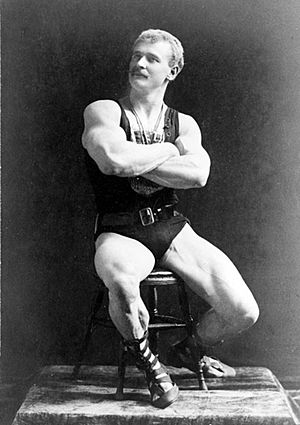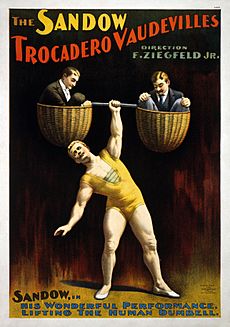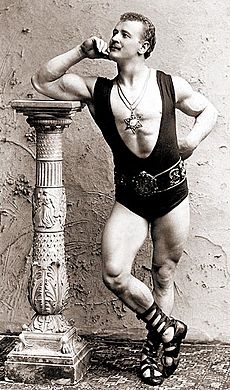Eugen Sandow facts for kids
Quick facts for kids
Eugen Sandow
|
|
|---|---|
 |
|
| Born |
Friedrich Wilhelm Müller
2 April 1867 |
| Died | 14 October 1925 (aged 58) Kensington, London, England
|
| Resting place | Putney Vale Cemetery |
| Other names | Eugene Sandow |
| Height | 175 cm (5 ft 9 in) |
| Spouse(s) |
Blanche Brooks
(m. 1896) |
| Children | 2 |
Eugen Sandow (born Friedrich Wilhelm Müller, 2 April 1867 – 14 October 1925) was a famous German bodybuilder and showman. He was born in Königsberg, Prussia. Sandow became interested in bodybuilding when he was ten years old during a trip to Italy.
After working in a circus, Sandow learned from a strongman named Ludwig Durlacher in the late 1880s. Durlacher encouraged him to join strongman competitions. Sandow competed against top athletes like Charles Sampson and Henry McCann. In 1901, he organized what many believe was the world's first major bodybuilding competition. This event took place in London at the Royal Albert Hall. Sandow was one of the judges, along with the famous author Sir Arthur Conan Doyle.
Contents
Early Life and Training
Eugen Sandow was born in Königsberg, Prussia (now Kaliningrad), on April 2, 1867. His family was Lutheran. In 1885, he left Prussia to avoid military service. He traveled across Europe and became a circus athlete. During this time, he started using the stage name Eugen Sandow. This name came from his mother's maiden name, Sandov.
In Brussels, Sandow visited the gym of another strongman, Ludwig Durlacher, also known as "Professor Attila." Durlacher saw Sandow's amazing potential. In 1889, he encouraged Sandow to go to London and compete in a strongman contest. Sandow easily beat the current champion. This win made him instantly famous for his strength. Soon, people from all over Britain wanted to see him perform. For the next four years, Sandow improved his skills. He turned his strength displays into popular entertainment, adding posing and incredible feats of strength.
A Star is Born
A show producer named Florenz Ziegfeld wanted Sandow to perform at the 1893 World's Columbian Exposition in Chicago. Ziegfeld noticed that audiences were more amazed by Sandow's muscles than by how much weight he lifted. So, Ziegfeld had Sandow do special poses to show off his muscles. He called these "muscle display performances." Sandow added these poses to his routine, along with lifting heavy barbells. Ziegfeld also added exciting acts like breaking chains around his chest. Sandow quickly became Ziegfeld's first big star.
In 1894, Sandow appeared in a short film series made by Edison Studios. The film showed him flexing his muscles instead of lifting weights. This showed how much people were interested in his amazing physique. In April of that same year, Sandow performed his muscle display show at an exposition in California.
While touring in the United States, Sandow briefly returned to England. He married Blanche Brooks, a woman from Manchester. After a period of rest due to stress, he returned to England permanently.
Building a Fitness Empire
Sandow soon recovered and opened his first "Institutes of Physical Culture." Here, he taught people about exercise, healthy eating, and weight training. His ideas about fitness were new and had a huge impact. The Sandow Institute was one of the first gyms open to the public.
In 1898, he started a monthly magazine called Physical Culture. It was later renamed Sandow's Magazine of Physical Culture. This magazine focused on all parts of physical fitness. He also wrote a series of books between 1897 and 1904. One of these books was titled "body-building," which was the first time this term was used!
Sandow also worked hard to improve exercise equipment. He invented things like rubber bands for stretching and special dumbbells with springs to strengthen wrists.
The First Bodybuilding Contest
In 1901, Sandow organized the world's first major bodybuilding competition. It was held at London's Royal Albert Hall. So many people wanted to attend that some were turned away. The three judges for the contest were Sir Charles Bennett Lawes, a sculptor, Sir Arthur Conan Doyle, the author, and Sandow himself.
In 1902, Sandow faced a challenge from Katie Brumbach in a weightlifting contest in New York City. Brumbach lifted 300 pounds over her head. Sandow could only lift it to his chest. After this victory, Brumbach took the stage name "Sandwina," which was a female version of Sandow.
In 1906, Sandow was able to buy a large house in London. This was thanks to a generous gift from an Indian businessman, Sir Dhunjibhoy Bomanji. Sir Dhunjibhoy's health had greatly improved after following Sandow's fitness program. This house, named Dhunjibhoy House, was Sandow's home for 19 years.
Sandow traveled the world, giving performances in places like South Africa, India, Japan, Australia, and New Zealand. From 1909, he even offered free training to people who wanted to join the Territorial Army. He helped them get fit enough to join. He did the same for volunteers during World War I. In 1911, King George V, who also followed Sandow's teachings, named him a special instructor in physical culture.
The Grecian Ideal
Sandow looked a lot like the strong, muscular figures found in ancient Greek and Roman sculptures. This was not by chance! He actually measured statues in museums. He used these measurements to create "The Grecian Ideal," which was his formula for the "perfect physique." Sandow built his own body to match these exact proportions. Because of this, he is known as the father of modern bodybuilding. He was one of the first athletes to purposefully develop his muscles to specific sizes. In his books, Strength and How to Obtain It and Sandow's System of Physical Training, Sandow gave clear instructions on how to use weights and repetitions to achieve his ideal body shape.
Personal Life
Sandow married Blanche Brooks in 1894. She was the daughter of a famous photographer from Manchester, England. They had two daughters, Helen and Lorraine.
Influence on Yoga
When Sandow visited India in 1905, he was already a "cultural hero" there. At that time, India had strong feelings of nationalism. Some experts believe that Sandow had a big influence on modern yoga as exercise. Many exercise routines from "physical culture" were included in yoga practices in the early 20th century.
Death and Legacy
Eugen Sandow died at his home in Kensington, London, on October 14, 1925, at age 58. Newspapers reported that he died from a brain hemorrhage. It was said that this happened after he strained himself trying to lift his car out of a ditch a few years earlier. However, without a full examination, his death was officially recorded as due to an aortic aneurysm.
Sandow was buried in an unmarked grave in Putney Vale Cemetery. This was at the request of his wife, Blanche. In 2002, a gravestone and a black marble plaque were added by a Sandow fan and author named Thomas Manly. The plaque called him "Eugen Sandow, 1867–1925, the Father of Bodybuilding." In 2008, Sandow's great-grandson, Chris Davies, bought the grave. A new, large stone monument was placed there, simply saying "SANDOW 1867–1925." This stone looks like ancient Greek monuments.
Sandow was friends with important people like King George V, Thomas Edison, Sir Arthur Conan Doyle, and pianist Martinus Sieveking. An actor named Nat Pendleton played him in the Oscar-winning film The Great Ziegfeld (1936).
To honor his contributions to bodybuilding, a bronze statue of Sandow is given to the winner of the Mr. Olympia contest. This is a major professional bodybuilding competition. The statue, sculpted by Frederick Pomeroy, has been presented since 1977 and is simply known as "The Sandow."
In 2013, Canadian bodybuilder Dave Simard played Eugen Sandow in the film Louis Cyr. In 2018, a film about Sandow's life called Sandow was made.
A cold brew coffee company in London, "Sandows," is named after him. In 2009, English Heritage placed a blue plaque on his house at 161 Holland Park Avenue in west London. It describes him as a "Body-Builder and Promoter of Physical Culture."
See also
 In Spanish: Eugen Sandow para niños
In Spanish: Eugen Sandow para niños
- List of male professional bodybuilders
- List of female professional bodybuilders
- Strongman (strength athlete)





